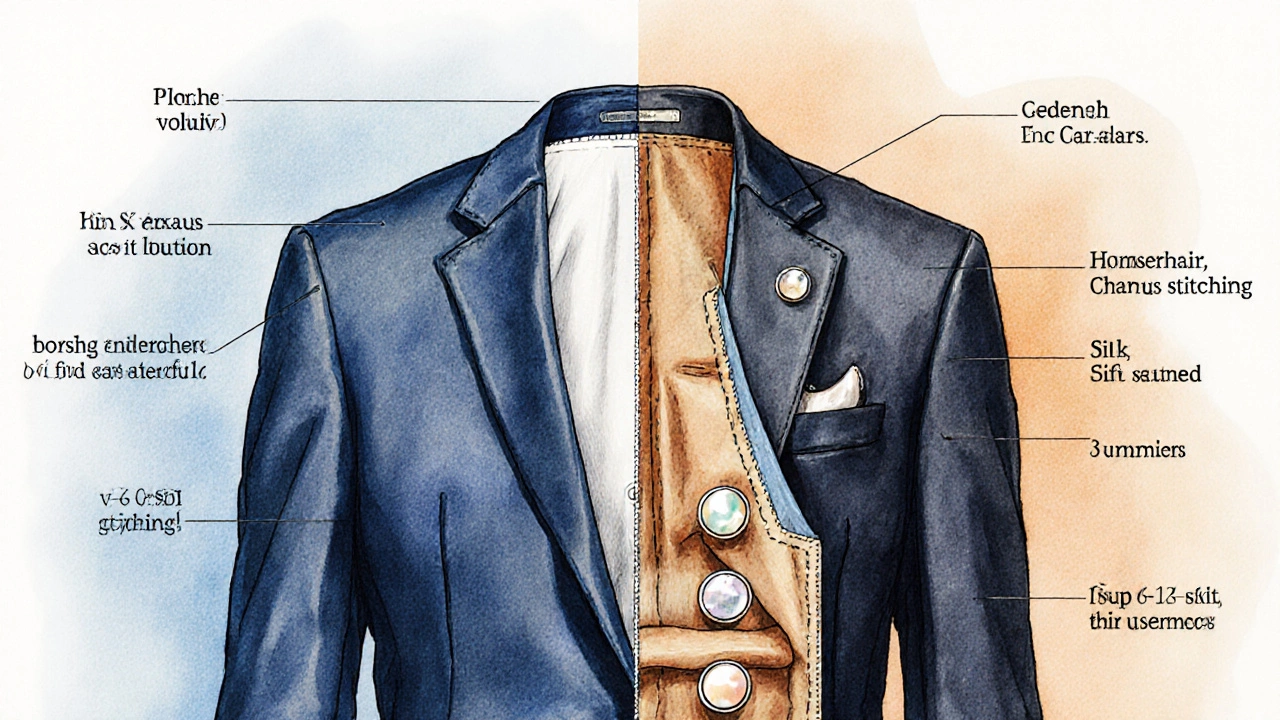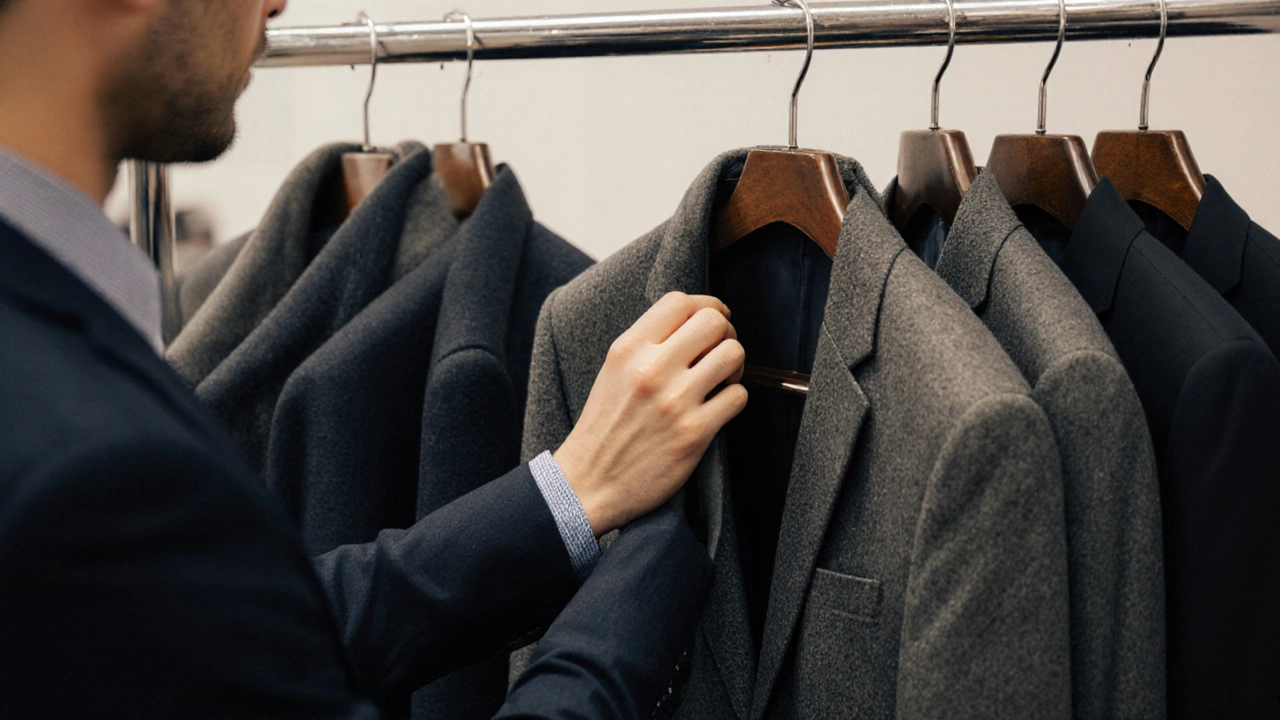How to Spot a Cheap Suit vs an Expensive Suit

Suit Quality Checker
Answer these key questions to determine the quality of a suit based on the article's criteria
Key Takeaways
- Fabric type and weight are the biggest price drivers.
- Full‑canvas construction beats fused or half‑canvas for durability.
- Real horn or mother‑of‑pearl buttons signal higher quality.
- A proper fit from a good tailor turns even a mid‑range suit into a polished look.
- Look at stitching, lining, and care instructions for clues about longevity.
Understanding the Basics
When you walk into a shop and see a row of suits, the first thing you ask yourself is - expensive suit or cheap imitation?
Both can look sharp at first glance, but the details tell a different story. This guide breaks down each element that separates a budget piece from a premium one, so you can spot the difference without needing a fashion degree.
Fabric Matters
Fabric is the material that makes up the body of a suit, affecting drape, breathability, and durability. The most common high‑end fabrics are Super100s to Super200s wool, cashmere blends, and fine linen for summer. These fabrics are measured in “Super” numbers, which indicate the weight of the yarn - the higher the number, the finer (and usually pricier) the wool.
Cheap suits often use polyester, viscose, or low‑grade wool blends. They feel stiffer, don’t breathe well, and show wear quickly. A quick test: rub the shoulder area; high‑quality wool will feel soft and slightly warm, while synthetic blends feel cold and slick.

Construction Techniques
Construction refers to how the suit’s pieces are assembled, influencing shape retention and comfort. The gold standard is a full‑canvas interior, where layers of horsehair canvas run from the lapel through the chest and down the front.
Full‑canvas suits mold to your body over time and repair themselves when stressed. Half‑canvas uses canvas only in the chest area and is a step up from fused (glued) construction, which is common in cheap suits. Fused suits can crack at the seams after a few wears, causing a sagging look.
Lining and Details
Lining is the inner layer that adds smoothness and helps the jacket slide on and off. Premium linings are made from silk, Bemberg (a cupro fiber), or breathable cotton. They feel cool against the skin.
Budget suits often have polyester lining that traps heat and shows stains easily. Look at the seam where the jacket meets the sleeve - a neat, reinforced edge indicates careful construction.
Stitching and Buttons
Stitching is the thread work that holds the suit together, measured by the number of stitches per inch (SPI). A high‑end suit typically has 10‑12SPI, giving a tight, clean appearance that resists fraying. Low‑quality suits may have 6‑8SPI, which can come undone after a few washes.
Buttons are often overlooked, but they’re a clear sign of price tier. Real horn, mother‑of‑pearl, or high‑grade metal buttons are used on expensive suits. Cheap suits rely on plastic or low‑grade resin that chips or fades.

The Fit Factor
Fit describes how the suit conforms to your body’s shape, affecting both comfort and style. A well‑tailored suit will have shoulders that sit flat, sleeves that show about a quarter inch of shirt cuff, and a taper that follows the torso without pulling.
Even an expensive fabric looks sloppy if the cut is off. Many high‑end brands sell “off‑the‑rack” options that still require a quick adjustment at a good tailor. A cheap suit rarely offers enough fabric in the seams to make proper alterations.
Brand Reputation and Tailoring
Brand is the label behind the suit, often linked to heritage, quality control, and after‑sales service. Well‑known house names (e.g., Savile Row, Brioni, Canali) typically guarantee a baseline of quality. Emerging designers can also deliver excellent value, but they’ll be transparent about materials and construction.
When you buy a suit, ask about the tailor who will finish the garment. A reputable tailor inspects the canvas, checks stitching, and offers a fitting schedule. Investing a little in a proper alteration can turn a mid‑range suit into a custom‑look piece.
Care and Longevity
How a suit is cared for can mask or magnify its quality. High‑end suits usually come with a care tag recommending dry‑clean only, low‑temperature pressing, and proper storage in a breathable garment bag.
Cheap suits may have a “machine wash” tag - a red flag. Washing destroys the delicate fibers and can ruin the canvas. Regular brushing, spot cleaning, and rotating wear extend a suit’s life and keep it looking fresh.

Quick Checklist: Spotting a Cheap Suit
- Feel the fabric - synthetic feel = cheap.
- Check the inside: fused canvas? Plastic lining?
- Look at button material - plastic vs horn or metal.
- Count stitch density - fewer stitches mean lower quality.
- Test the fit - shoulders should lie flat, sleeves proper length.
- Read the care label - dry‑clean only is typical for quality wool.
Comparison Table
| Feature | Cheap Suit | Expensive Suit |
|---|---|---|
| Fabric | Polyester blend, low‑grade wool | Super120s wool, cashmere blend, silk‑woven |
| Construction | Fused (glued) or half‑canvas | Full‑canvas with horsehair, hand‑stitched |
| Lining | Polyester, often visible | Silk, Bemberg, or breathable cotton |
| Stitching (SPI) | 6‑8SPI, visible gaps | 10‑12SPI, tight, uniform |
| Buttons | Plastic or low‑grade resin | Horn, mother‑of‑pearl, or high‑polish metal |
| Fit Adjustability | Limited seam allowance | Generous seam allowance, easy tailoring |
| Price (USD) | $150‑$300 | $800‑$3000+ |
| Care Label | Machine‑washable (often) | Dry‑clean only, low‑temp press |
Frequently Asked Questions
What fabric should I look for in a premium suit?
High‑end suits usually feature Super 100s‑200s worsted wool, cashmere blends, or high‑quality linen for summer. These fabrics have a soft hand, natural drape, and good breathability.
Is full‑canvas really worth the extra cost?
Yes. Full‑canvas construction lets the suit conform to your body over time, repairs minor stress points, and prevents the lapels from looking stiff. It’s a key reason why a suit can last decades with proper care.
Can I alter a cheap suit to look better?
Minor tweaks like hemming sleeves or taking in the waist are possible, but cheap suits often have limited seam allowance and low‑grade stitching, so major changes won’t hold up well. It’s better to invest in a better base.
How often should I dry‑clean a high‑end suit?
Ideally after 5‑6 wears, unless it gets stained. Over‑cleaning can wear down the fibers, so spot clean when possible and let the suit air out after each use.
Do button materials really affect durability?
Absolutely. Horn and mother‑of‑pearl age gracefully and can be re‑polished, while plastic buttons become brittle and crack. Metal buttons are sturdy but can dent if hit hard.
By paying attention to fabric, construction, lining, stitching, buttons, fit, and brand reputation, you can confidently tell a cheap suit from an expensive one. The next time you shop, use this checklist and walk away with a suit that not only looks great but lasts for years.
- Oct, 14 2025
- Violet Greenfield
- 0
- Permalink
Written by Violet Greenfield
View all posts by: Violet Greenfield